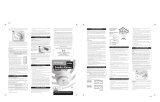
3. TEST THIS SMOKE ALARM ONCE A WEEK. IF THE ALARM EVER FAILS TO TEST
CORRECTLY, REPLACE IT IMMEDIATELY! IF THE ALARM CANNOT WORK PROPERLY,
IT WILL NOT ALERT YOU TO A PROBLEM.
How to Set up and Interconnect Wireless Alarms
All X-Sense Link+ wireless interlinked alarms contain a built-in RF module that enables you to
wirelessly connect 2 or more interlinked alarms and create an interlinked network. When one unit is
triggered, all interconnected alarms will sound. The X-Sense Link+ series contain wireless interlinked
smoke alarms, wireless interlinked carbon monoxide alarms, and wireless interlinked combination
smoke and carbon monoxide alarms. This model is designed to be wirelessly interlinked with other
X-Sense Link+ alarms, but is not designed to communicate with wireless interlinked alarms from other
manufacturers.
The X-Sense Link+ wirelessinterlinked alarms in one multi-pack have already been
interconnected, and the alarms in each multi-pack have their own independent interlinked
network. If you have more than one multi-pack, you will need to connect them all to the same
network. Choose one multi-pack as your base network and connect the other multi-packs to it.
NOTE: The following instructions regarding wireless interconnection are applicable to the X-Sense
Link+ wirelessinterlinked alarms only.
How to Interconnect
1. Make sure you only work with 2 units at a time, and make sure that they are both turned on to
ensure successful connection.
NOTE: To turn on SD19-W/SD20-W, attach the alarm to the mounting bracket and turn
clockwise to lock it. To learn how to turn on different models of wireless interlinked alarms,
please refer to their specific user manual for more details.
2. Quickly press the test/silence button on one of the 2 units 4 times; it will beep once and the red
LED will flash slowly, indicating it has entered pairing mode and is waiting for a new unit to be
added. Quickly press the test/silence button on the other unit twice; it will beep once and the red
LED will flash rapidly, indicating it is searching for a device to connect to.
3. After the search is successfulandan interconnected group is created, both units will beep once and
automatically exit the interconnection mode. At this point, both units will only flash once 60
seconds, indicating they are in normal standby mode.
4. If you want to connect a third alarm to this group, first activate a new device according to its
operating instructions, andthen quickly press the test/silence button on either of the 2 previously
interconnected units 4 times. This unit will beep once, and the red LED will flash slowly,
indicating it is ready to add a new device to the network. Next, quickly press the test/silence
button on the new unit twice, and the red LED will flash rapidly as it searches for a network to













